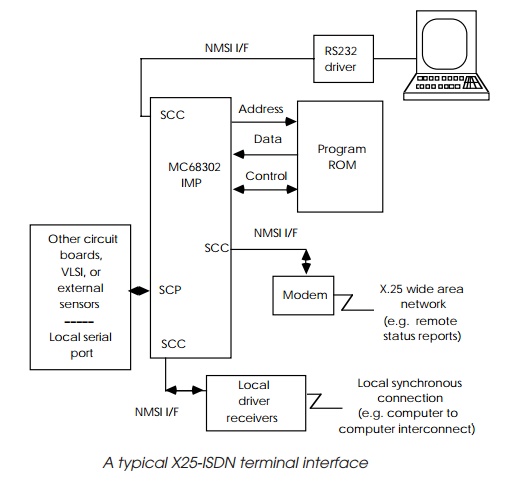Chapter: Embedded Systems Design : Embedded processors
Integrated processors
Integrated processors
With the ability of semiconductor manufacturers to be able to integrate
several million transistors onto a single piece of silicon, it should come as
no surprise that there are now processors available which take the idea of
integration offered by a microcontroller, but use a high performance processor
instead. The Intel 80186 started this process by combining DMA channels with an
8086 architecture. The most successful family so far has been the MC683xx
family from Motorola. There are now several members of the family currently
available.
They combine an M68000 or MC68020 (CPU32) family processor and its
asynchronous memory interface, with all the standard interface logic of chip
selects, wait state generators, bus and watchdog timers into a system interface
module and use a second RISC type processor to handle specific I/O functions.
This approach means that all the additional peripherals and logic needed to
construct an MC68000- based system has gone. In many cases, the hardware design
is almost at the ‘join up the dots’ level where the dots are the processor and
memory pins.
This approach has been adopted by others and many differ-ent processor
cores, such as SPARC and MIPs, are now available in similar integrated
processors. PowerPC versions of the MC68360 are now in production where the
MC68000-based CPU32 core is replaced with a 50 MHz PowerPC processor. For
embedded systems, this is definitely the way of the future.

The MC68302 uses a 16 MHz MC68000 processor core with power down modes
and either an 8 or 16 bit external bus. The system interface block contains
1152 bytes of dual port RAM, 28 pins of parallel I/O, an interrupt controller
and a DMA device, as well as the standard glue logic. The communications
processor is a RISC machine that controls three multiprotocol channels, each
with their own pair of DMA channels. The channels support BISYNC, DDCMP, V.110,
HDLC synchronous modes and stand-ard UART functions. This processor takes
buffer structures from either the internal or external RAM and takes care of
the day-to-day activities of the serial channels. It programs the DMA channel
to transfer the data, performs the character and address compari-sons and
cyclic redundancy check (CRC) generation and check-ing. The processor has
sufficient power to cope with a combined data rate of 2 Mbits per second across
the three channels. Assum-ing an 8 bit character and a single interrupt to poll
all three channels, the processor is handling the equivalent of an interrupt
every 12 microseconds. In addition, it is performing all the data framing etc.
While this is going on, the on-chip M68000 is free to perform other functions,
like the higher layers of X.25 or other OSI protocols as shown.

The MC68332 is similar to the MC68302, except that it has a CPU32
processor (MC68020-based) running at 16 MHz and a timer processor unit instead
of a communications processor. This has 16 channels which are controlled by a
RISC-like processor to perform virtually any timing function. The timing
resolution is down to 250 nanoseconds with an external clock source or 500
nanoseconds with an internal one. The timer processor can per-form the common
timer algorithms on any of the 16 channels without placing any overhead on the
CPU32.
A queued serial channel and 2 kbits of power down static RAM are also
on-chip and for many applications, all that is required to complete a working
system is an external program EPROM and a clock.
This is a trend that many other architectures are following especially
with RISC processors. Apart from the high performance range of the processor
market or where complete flexibility is needed, most processors today come with
at least some basic peripherals such as serial and parallel ports and a simple
or glueless interface to memory. In many cases, they dramatically reduce the
amount of hardware design needed to add external memory and thus complete a
simple design. This type of processor is gaining popularity with designers.

Related Topics